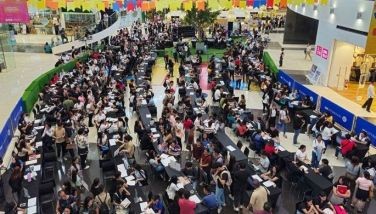A hot pursuit

My first encounter with sea urchin happened in Sicily way back in 1979. I was a backpacker living on a shoestring budget of US$10 a day, traveling on a Eurail pass and staying in youth hostels for $2 a night (a bottle of house wine cost then a ridiculous sum of $0.50!, while a liter of mineral water was $1, sin gas o con gas). Foraging the market of Palermo, I chanced upon this fishmonger selling the sea creatures called ricci di mare, already opened and clean on its globular half-shell with the top cut off, exposing five-fold symmetrical bright orange gonads like a starfish inside a hard dark cup of a shell. Curiosity got the better part of me, and I found myself queuing up to buy half a dozen pieces while asking the guy in front of me how they were eaten.
After I got my loot, I hied off to the nearest bench I could find, squeezed some lemon on them, and scooped out the fatty roe with the crust of a country bread I had bought earlier. The raw urchin carried an exotic flavor to my uninitiated taste buds, with its complex sea taste of salty sweetness that was at once pleasing and revolting with its slimy mush, not unlike holding on to one’s own phlegm, not knowing where to spit it out (eew!). It reminded me of durian which one either loves or hates, and none in between. Unfortunately for the poor urchin, I got hooked, leaving an indelible impression forever etched on my palate.
Over the years, I got to try it prepared in so many different ways and settings. Called uni by the Japanese, it is popularly served raw as sashimi (by itself) or as sushi (with vinegared rice), dipped invariably with soy sauce and wasabi. It is also prepared as a tempura, stuffed in a nori (seaweed) cone, dipped in batter, and then deep-fried. It has since become one of my favorite foods in its raw form; in fact, it’s the main reason I go eat in a Japanese restaurant and would rather eat elsewhere if they don’t have it available. In other chichi establishments, it is used to flavor pastas, soups and sauces for other seafood dishes much like our own taba ng talangka or crab fat.
A couple of months ago, there was a Davao food festival at the Jeepney Coffee Shop of the Intercontinental Manila, with Paddy Lascano as guest chef. During the media lunch interview, he mentioned his life-long research into Mindanaoan cuisine, especially of the Maranaos, Tausugs and Bagobos. Though he doesn’t have his own restaurant back in Davao, he has established himself at the forefront of the field, and is a most sought-after consultant to such special culinary events. And, like the proverbial “always a bridesmaid but never the bride,” he has contributed countless recipes to other authors’ cookbooks but never his own.
One of the more memorable dishes he prepared was the tuyom or sea urchin roe served with a green mango and tomato relish over a bed of salad greens. Though it’s the same uni we’ve come to be familiar with in Japanese restaurants, the tuyom has a more runny consistency but nevertheless has the same linamnam (called umami by the purveyors of MSG) that brings about a kilig that only a Filipino can relate to. It’s a thrill of emotion or excitement, a tingling sensation or even quiver down the spine, if you will. (Sounds almost orgasmic, doesn’t it?) A spoonful of the silken smooth creamy stuff rolled onto one’s tongue to the back of the throat is enough to create an explosion of the ocean with its cloyingly rich, sweet briny taste.
But what really grabbed my attention was Lascano’s recounting a firsthand experience with the Tausugs, of rice being cooked in sea urchin shells with all its glorious roe left in it. A thought balloon burst in my face like a car’s airbag explosion: Boom! “How come in all my years of gourmandizing, I’ve never, ever come across something like that?” I asked myself.
Being one of my favorite delicacies, I was intrigued no end — nay, overly aroused, as in sobra (I warned you, it’s becoming more and more like food porn) — by this idea so that it became an obsession to track it down, witness its cooking and try it firsthand. I promised (threatened was more like it) Lascano that I’d look him up on a forthcoming trip to Davao. Like a pesky street urchin (no pun intended) begging for money, I couldn’t shake the balloon off my mind: “Gotta have it, gotta have it...” It was a dish begging to be discovered.
Weeks later, finding myself in Davao City, I kept my promise of calling Lascano up. Partly due to ignorance and failing to do my homework, little did I know that the Tausugs are no way near Davao but live mainly in the Sulu archipelago, nearer to Borneo than any part of the Philippines. After all, they aren’t referred to as the “people of the current” (because of their affinity to the sea) for nothing. “Don’t lose heart,” he said, tipping me off just the same that I’d find tuyom at the Muslim market Km. 11, locally called “Kilometro Once.” The market’s name alone had an auspicious sound to it, boosting once again my deflating balloon.
By 7 a.m. the following morning, I was walking along the single narrow lane of market Km. 11, just as Lascano had described it. Tagging along with me was the driver of the rented van to act as my interpreter if needed. To my chagrin, there was no tuyom in sight, and not much of a market either. It was nearly empty. Lascano had forgotten to mention one minor but important detail — it’s an afternoon market! I learned from a lone lady fishmonger that the market comes alive starting only at 3 p.m. when the fresh catch arrives. Furthermore, she said, the elusive tuyom is sold already shelled, the roe contained in recycled lapad or flat rum bottles (same as with the markets I’ve seen in Cebu, Bohol and Ormoc). My diligence had failed me again with a near total collapse of my balloon.
“Do they sell tuyom still in its shell?” I asked the lady in Tagalog, close to tears in frustration.
“No, never. Always in a bottle” she answered.
“And where can I find it still in its shell?” I persisted.
“Ah, for that, you’d have to cross to Samal and go where the fishermen are. They would be out fishing about this time,” she said.
“Where and how do I find them?” I asked.
“At the end of this lane is the Sasa terminal. Take the ferry to Babak. Trece pesos (P13) lang ang bayad. When you reach the other side, take the habal-habal (motorbike) to bring you to the baybay (shore) where the fishermen are,” were the general directions I was to follow.
Weighing my options, I resolved at this point I would not leave Davao empty-handed. It was a do-or-die situation, and I needed little convincing to go for it. Acting on impulse, I instructed the driver to go back to the apartelle where I was staying, in case my wife Mary Ann and the rest of our traveling companions might need him. Earlier, I left my wallet with Mary Ann but brought with me my driver’s license (for identity), cell phone, some P700 in cash and my camera, thinking I was only going to shoot in the market. But in my haste I forgot to bring a pen and notebook, which, fortunately, were available at a sari-sari store on the way to the wharf.
Although the 20-minute ferry ride across the Pakiputan Strait (literally a narrow channel) was a breeze, my thought balloon was resuscitated, but with a different tune this time around. Had I made a foolhardy decision, threading out into the unknown? What if the ferry capsizes? What if I was held hostage by a kidnap-for-ransom gang? Snapping myself back to reality, I was actually happy playing the role of a tourist, enjoying the peace and quiet, sitting at the back of the ferry. After all, I was heading to the Island Garden City of Samal. What could possibly go wrong in a place with such a green-sounding official name like that? “Seize the moment, seize the moment!” became my new mantra.
Walking out on the Babak wharf, I was greeted by several men soliciting me for a contracted motorbike ride, known locally as habal-habal. It is the popular mode of public transport in most undeveloped parts of Mindanao where the narrow, rugged and steep roads are oftentimes inaccessible by jeepneys and tricycles. With the standard saddle seat at the back of the operator designed to fit only one passenger, an extension is installed hanging over the back wheel, like a bird tail, to include two more additional passengers. A fourth smaller person (say a child) can sit sidesaddle on the gas tank in front of the driver. I had come across a more complex one called Skylab some five years ago on a RORO trip to Mindanao. It was outfitted with a wooden plank placed perpendicularly across the saddle seat, and could accommodate up to a dozen persons as well as their baggage (and cargo that could include livestock and produce in bushels), but that’s a different story altogether.
Wanting to reserve the vehicle exclusively for my use, I negotiated with the first guy who approached me, named Toto, giving him the same general instructions to bring me to the baybay where the fishermen were and back.
“I want to catch some tuyom, you know?” I said, as if it mattered to him.
“Okay, po,” was all he replied. And with that, I blindly rode his bike without really knowing where he’d take me.
Ten minutes into the ride we were passing through Babak Centro’s row of commercial stalls. I told Toto to stop for me to buy some bottled water. Seeing a rice dealer next door, I bought half a kilo remembering Lascano’s instructions of soaking the rice first in water before placing it inside the urchin shells. I had it double bagged, pouring half a bottle of water into it, planning ahead just in case I’d find the elusive tuyom shells and maybe cook it on site. “Looking good, looking good,” became my next mantra.
Another 10 minutes of rough ride brought us to what seemed our final destination — the baybay in barangay Kamudmud, still in Babak town. We initially slowed down, avoiding the potholes and rocks protruding from the dirt road (just a pathway of exposed earth, really) and came to a complete halt. Suddenly, we were surrounded by a motley group of curious usiseros or bystanders (more like “busybody” or “nosy person,” elevated into a national sport in this country). They came from a bigger throng just a few meters away, watching a real-life drama (you see what I mean?) of what seemed to be a domestic squabble between two women, replete with all the screaming and cursing (and hair pulling, I imagined). A man was struggling to wrest away the younger of the two. Our arrival distracted a few of the audience, like a sideshow, as they walked towards us, while the rest remained glued to the main attraction.
Toto explained to the more senior man in the group what I had come for.
“I have a bangkâ,” the senior man told me directly. “My boys can take you to catch tuyom,” he said.
“O sige, but how much will you charge me?” I asked cautiously.
“P1,000,” he replied.
“Look, all I have is less than P700. I can give you P400. I still have to pay Toto here P200 for the habal ride. That’s all I can offer, and if you won’t take it, I’d have to leave and head back to Davao,” I said, giving my most forlorn look. It was a calculated gambit but I was hoping against hope he’d take it. The pesky thought balloon erupted once again, and it must have reverberated to the high heavens: “Oh, pleeease say yes!” Holding my breath, I implored all the angels and saints, praying like I’ve never prayed before.
The man hesitated a bit for what seemed like eternity and finally said: “Okay, follow me.”
With a big sigh of relief, I instructed Toto to wait for me and hold on to the bag of rice. Arnel, the boat owner, then led me to a cluster of houses on stilts about five rows deep onto the sea, walking on a coco lumber catwalk, past laundry lines and outhouses. He walked through briskly with such familiarity and dexterity of steps, and barefooted at that. I, on the other hand, threaded gingerly behind, mindful of every step on the uneven, loose convex planks. A misstep could easily result in a foot falling through a gap, or worse, falling into the water in the absence of any railing to hold on to. More than the thought of losing my camera (it’s replaceable, I reasoned), it was the dreadful outhouse scene from the movie Slumdog Millionaire flashing in my mind that scared me most. Yuck!
As I finally reached the bangkâ and settled myself at the midsection, it was pushed down in its berth by two boatmen, Kekeng and Edwin. Fifteen minutes out onto the sea, Kekeng turned off the engine and threw the anchor overboard. We were midway between Davao City and Samal Island along the strait, a bit north of Sasa wharf were I started earlier. It was a bright sunny morning where the coastlines on both sides can be seen, and one could see the white sand and coral formations below the clear blue waters.
Edwin repositioned himself at the bow, sitting sidesaddle to put his worn-out mask and homemade flippers of plywood and recycled rubber tube. By his side were a spear and ringed fishnet sack. Kekeng then moved towards him to prepare the compressor to pump air through a roll of plastic tube. When all was set, Edwin jumped into the water for the hunt.
Waiting on the boat, I was scribbling some notes while Kekeng sat himself at the bow, paddling the tube with one foot in a circular motion to keep the air flowing. The water had turned choppy with a sudden gust of wind, blurring the view below. Still, one could track Edwin’s whereabouts with the clusters of large air bubbles surfacing every now and then, at changing orientations from where we sat. Some 20 minutes later, he emerged at the bangkâ’s right outrigger like a triumphant warrior after his kill, raising his spear with an urchin still impaled on its end, and the sack half filled with the precious bounty.
Back on the boat, he shook and tossed the sack vigorously to break all the long spines off its shells and then dipped it in the water, repeating this motion several times. He then got one with his bare hand to show me how to open it. Carefully, he cut around the top using a blunt knife as seawater poured out of the shell, leaving a black web inside that held the roe together. Poking it with his pointing finger, he felt up around the shell’s interior to loosen all the dirt and then dipped and shook it in the water until all the dirt came out.
Some two hours later, I was back at the apartelle, all quiet and deserted (to my advantage) with my traveling mates gone somewhere. Its kitchen was equipped with some rudimentary cooking equipment including a rice cooker. Gingerly unpacking my loot, I set aside several “pretty” ones for the pictorial, while the rest I cut into halves to make it easier for me to extract the roe, which I planned to add to the rice filling. The presoaked rice came in handy, indeed. Recalling Lascano’s cooking instructions, all I needed were some banana leaves to cover the urchins’ holes. Lacking this, I made do with some used foil from the fridge’s sundries.
Placing some five rice-filled urchins into the cooker, I then poured enough water to reach two-thirds its capacity, adding a spoonful of sea salt for good measure. I felt like I was on a roll!
While waiting for it to cook, I prepared the mango garnish that’s supposed to be the Tausug’s relish of choice to go with the tuyom rice. In the traditional meal, Lascano informed me, the green pajo or thumb-size mango variety is used, spiked with siling labuyo. In its absence, I bought two pieces of manibalang or half-ripe mangoes (the only ones available, actually) and five pieces of red chilies on my way out of the Km. 11 market. This had set back my near empty pocket further by another P6.
Oh, by the way, near the entrance of the market fronting the Pan-Philippine Hi-way (near the pedestrian overpass,) I chanced upon a food stall selling newly fried doughnuts, banana fritters, and a strange looking yellow-wrapped lumpia filled with a violet mash. It turned out to be haleyang ube, or at the very least, a kamote mash artificially colored violet. Curiosity struck me again, so I bought three pieces to go at P2 each, munching on the still-hot lovely rolls on the jeepney ride back to the apartelle.
After some 20 minutes into the boiling, I removed the urchins from the cooker. The cooked rice had expanded, filling each shell to the brim. Not able to contain my excitement, I poked into one (again, choosing the least photogenic) with a teaspoon. And? Well, most of the linamnam I hanker for from the roe was lost in the cooking. Though it still had a hint of the sea, it had a dry blandness to it, bereft of all the cloyingly rich sweet briny taste. Recalling my past meal experiences with cooked urchin, well, I concluded it just didn’t lend itself well to cooking. It is still best eaten in its raw form. Fortunately for me, though, I still had some raw roe left and spread it on the cooked urchin rice. And this made all the difference, and kept me roaring for more.
I came back from the morning adventure financially broke but feeling I’d won the lotto. I wouldn’t trade the journey’s experience for the world. After all, the proof of the pudding is in the eating, and I mean this in the literal sense. Burp!




















